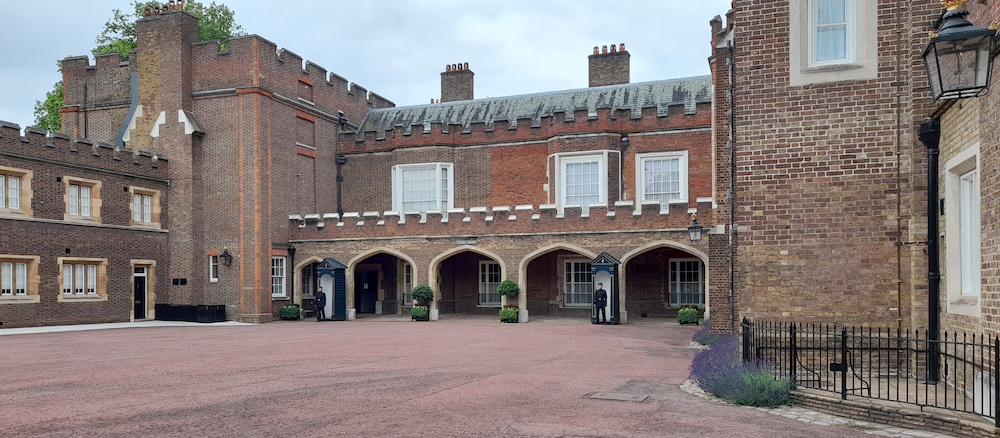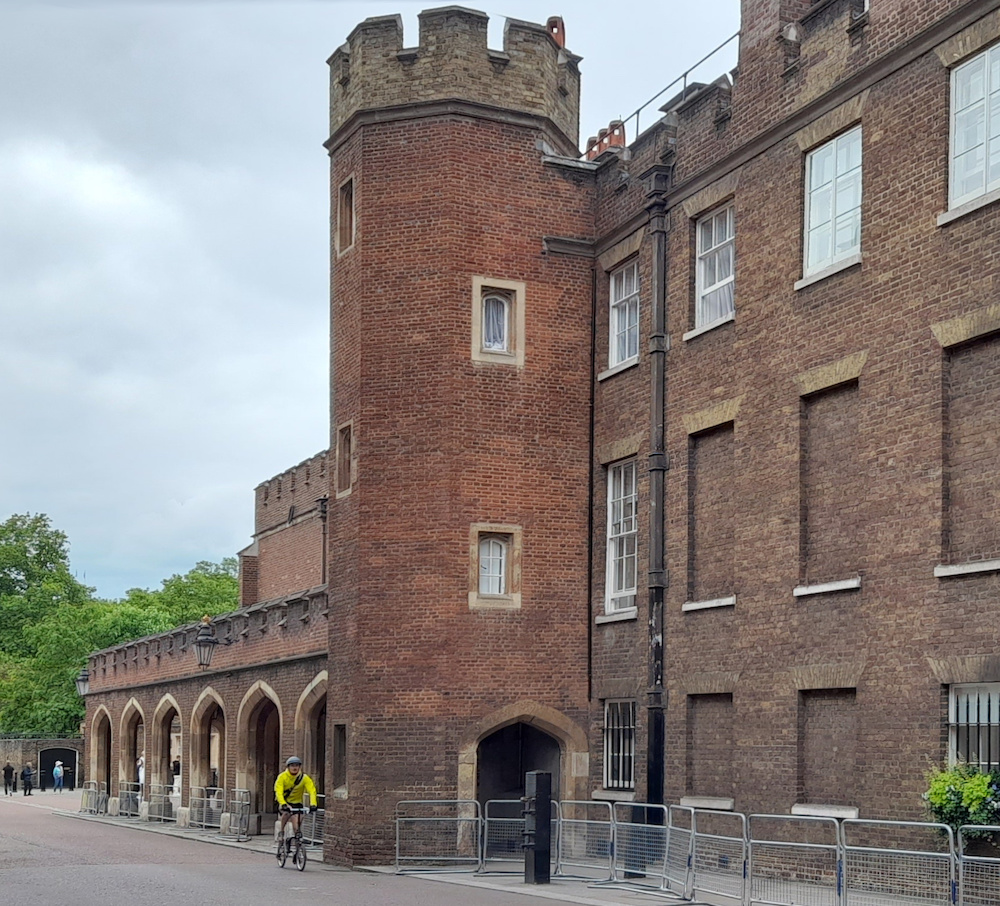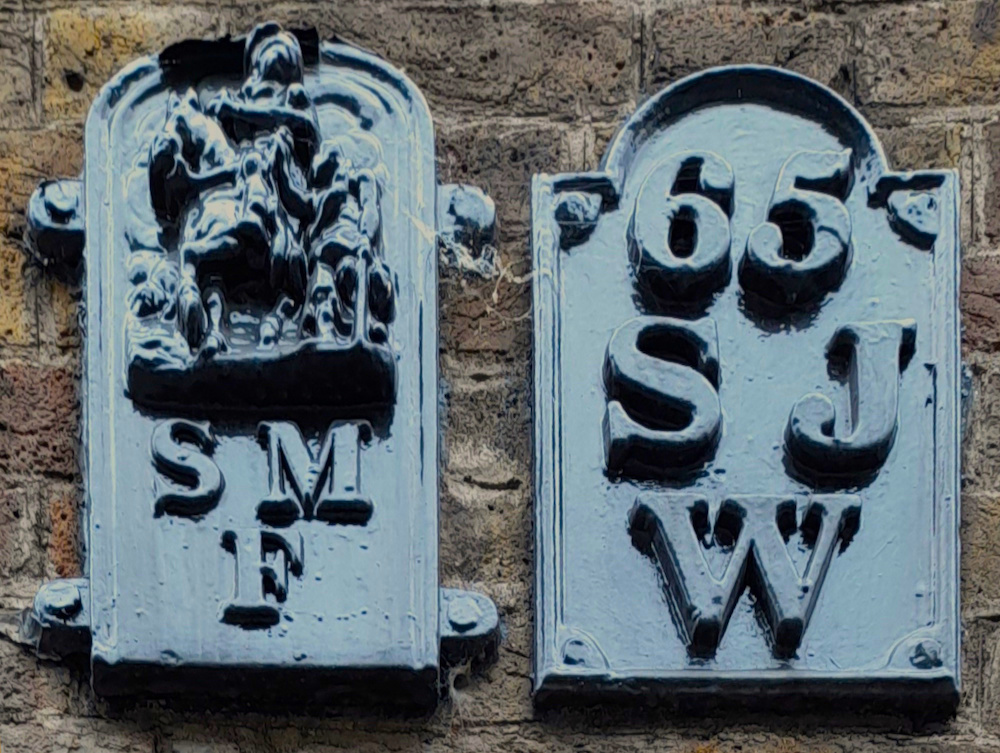
St James's Palace, north range, seen from the west end of Pall Mall. The palace was built c. 1533-35 for Henry VIII, possibly to the design of Hans Holbein, on a site previously occupied by a leper hospital:
St. James’s Palace, at the bottom of St. James’s Street and the south-west corner of Pall Mall, was built on the site of a hospital dating from before the Conquest and dedicated to St. James. Henry VIII obtained possession of the hospital, turned out the inmates, pulled down the buildings, and bought the surrounding meadows, and there built what was called the "Manor House," said to have been planned by Holbein — "a faire mansion and a parke for his greater commoditie and pleasure." Holbein’s Gate-house still faces St. James’s Street. [Fry 96]
As this suggests, the location was then a rural one, quite outside the populated area of London. The palace underwent later alterations, and needed much rebuilding after a major fire in 1809, but it remained one of the main royal residences for over 300 years. Since then the Grade I listed St James's Palace, now conveniently situated in the heart of town, close to Buckingham Palace, Whitehall, Westminster, clubland, art galleries and theatres, has continued to be used as a London residence for members of the royal family, and for various special functions (see Weinreb et al. 767).


Two views of the original interior, by C. Wild. Left: The Grand Chamber (described in the text as the "Great Guard Chamber"). Source: Pyne, facing p. 9. Right: The Queen's Levee Rooms. Source: Pyne, facing p. 15.
One of the earliest references to the palace in Queen Victoria's journals comes from her entry on her fourteenth birthday, on 24 May 1833:
At ½ past 7 we went with Charles, the Duchess of Northumberland, Lady Catherine Jenkinson, Lehzen, Sir George Anson, & Sir John, to a Juvenile ball that was given in honour of my birth-day at St. James's by the King & Queen. We then went into the closet. Soon after the doors were opened & the King leading me, went into the ball-room. Mad. Bourdin was there as dancing-mistress. Victoire was also there, as well as many other children whom I knew. Dancing began soon after. I danced first with my cousin George Cambridge, then with Prince George Lieven, then with Lord Brook, then Lord March, then with Lord Athelone, then with Lord Fitsroy Lenox, then with Lord Emlyn. We then went to supper. It was ½ past 11. The King leading me again. I sat between the King & Queen. We left supper soon. My health was drunk. I then danced one more quadrille with Lord Paget. I danced in all 8 quadrilles. We came home [to Kensington Palace] at ½ past 12. I was very much amused. I was soon in bed & asleep. [152-53]


Left: Floor plan of the palace by Simon Burgis, 1689, from Sheppard, facing p. 12. This shows the location of the Chapel Royal in the palace complex. Right: Chapel Royal, St James's. Source: Walford.
The palace's Chapel Royal and gatehouse survived the fire of 1809, making them the most authentic parts of the original structure. Although the latter was redecorated in about 1836, the ceiling is still thought to be as Holbein (probably) designed it (see Mee 181). Queen Victoria would never live at St James's, but she would be married at the chapel in 1840, as would Princess Victoria in 1858 and the future George V in 1893. Royal christenings still generally take place there (see Weinreb et al. 148).

The Marriage of Queen Victoria, 10 February 1840, by George Hayter from the Royal Collection Trust (click on this for more information).
Talking of redecoration, "The Armoury and Tapestry Rooms retain their Tudor fireplaces and were redecorated by William Morris and the firm in 1866-67" (listing text). Among the many art treasures in the palace is Valentine Prinsep's huge work, The Imperial Assemblage held at Delhi, 1 January 1877, occupying the whole wall on one side of the Banqueting Chamber.
Friary Court and Marlborough Road

Friary Court, with sentries on duty.
One of the four courts of the palace, and the only one seen from the outside, Friary Court is to the south-east, on Marlborough Road just off Pall Mall. It was named after Capuchin friars who originally came there in the seventeenth-century, when Charles II married Catherine of Braganza. "The buildings included a refectory, dormitory, chapel, and library, with cells for the religious" (Walford). According to the listing text, Friary Court is still partly of Tudor origin, but less extensive than it used to be, having had to be rebuilt "with 4 centred arcades in yellow brick" after the fire of 1809. Notable here, above the arches, is the Proclamation Gallery, from which a new monarch is announced to the nation. In the yard below, troops gather before marching to Buckingham Palace for the Changing of the Guard.


Left: Approach to Friary Court from Pall Mall, along Marlborough Road. Right: markers on the wall here: on the left, for the parish of St Martin-in-the-Fields to which it originally belonged, showing St Martin on horseback, giving his cloak to a beggar; on the right, for its location in the district of St James, Westminster.
The area is full of interest. On the opposite side of Marlborough Road are the west side of Marlborough House, now the Commonwealth Secretariat, and Alfred Gilbert's celebrated Queen Alexandra Monument. At the end of the road is the Mall, and the entrance to St James's Park.
Links to Related Material
- Victorian photograph of the Palace
- St. James' Palace — Old Clothes!, from The Cries of London & Public Edifices (1847)
Bibliography
"Descriptive Gazetteer Entry for JAMES (ST.) WESTMINSTER." A Vision of Britain through Time. Web. 6 June 2024.
Fry, Herbert. London: Illustrated by Eighteen Bird's-Eye Views of the Principal Streets. London: W. H. Allen, 1885. Google Books. Web. 6 June 2024. Free Ebook.
Mee, Arthur. London: Heart of the Empire and Wonder of the World. The King's England series. London: Hodder and Stoughton, 1937.
Pyne, W. H. The History of the Royal Residences of Windsor Castle, St James's Palace, Carlton House, Kensington Palace, Hampton Court, Buckingham House and Frogmore, Vol. III. London: A. Dry, 1819. Internet Archive. Contributed by the Getty research Institute. Web. 2 August 2021.
Queen Victoria's Journals. Web. 2 August 2021.
"St James's Palace, Garden Walls, etc." Historic England. Web. 2 August 2021.
"St James's Wallpaper, 1881. King & McGaw. Web. 2 August 2021.
Sheppard, Edgar. Memorials of St James's Palace, Vol. 2. London: Longmans, Green & Co., 1894. Internet Archive. Contributed by Harvard University. Web. 2 August 2021.
Walford, Edward. "St James's Palace." Old and New London: Volume 4. London: Cassell, Petter & Galpin, 1878. 100-122. British History Online. Web. 2 August 2021.
Weireb, Ben, Christopher Hibbert, Julia Keay and John Keay, eds. The London Encyclopaedia. 3rd edition. London: Macmillan, 2008.
Created 2 August 2021
Last modified (Friary Court added) 4 June 2024